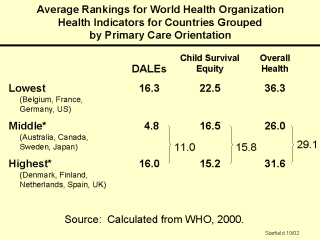| front |1 |2 |3 |4 |5 |6 |7 |8 |9 |10 |11 |12 |13 |14 |15 |16 |17 |18 |19 |20 |21 |22 |23 |24 |25 |26 |27 |28 |29 |30 |31 |32 |33 |34 |35 |36 |37 |38 |review |
 |
DALE: Disability
adjusted life expectancy (life lived in good health) Child survival: survival to age 2, with a disparities component Overall health: DALE minus DALE in absence of a health system Maximum DALE for health expenditures minus same in absence of a health system The World Health Organization ranked countries of the world on three health indicators. When the WHO rankings for the three groups of the 13 countries are averaged, the disadvantage of the poor primary care-oriented countries is apparent, particularly for equity of child survival to age 2, thus confirming that the special advantages of a primary care oriented health system is most notable the younger the age group, and indicating that the advantages of primary care extend beyond better average levels of health indicators to measures of better distribution of health (i.e., equity) within a country’s population. Source: World Health Organization. The World Health Report 2000. Health Systems: Improving Performance. Geneva: World Health Organization, 2000. |